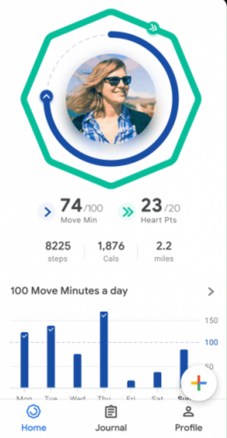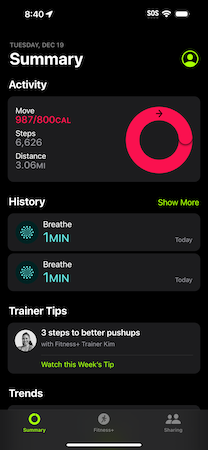
A heat map is a 2-dimensional data visualization technique that represents the magnitude of individual values within a dataset as a color. The variation in color may be by hue or intensity.

Google Calendar is a time-management and scheduling calendar service developed by Google. It was created by Mike Samuel as part of his 20% project at Google. It became available in beta release April 13, 2006, and in general release in July 2009, on the web and as mobile apps for the Android and iOS platforms.
Fitbit is a line of wireless-enabled wearable technology, physical fitness monitors and activity trackers such as smartwatches, pedometers and monitors for heart rate, quality of sleep, and stairs climbed as well as related software. It operated as an American consumer electronics and fitness company from 2007 to 2021.
Waze Mobile Ltd, doing business as Waze, formerly FreeMap Israel, is a subsidiary company of Google that provides satellite navigation software on smartphones and other computers that support the Global Positioning System (GPS). In addition to turn-by-turn navigation, it incorporates user-submitted travel times and route details while downloading location-dependent information over a cellular network. Waze describes its application as a community-driven initiative that is free to download and use.
Runkeeper is a GPS fitness-tracking app for iOS and Android launched in 2008. In late 2011, Runkeeper secured $10 million in a Series B financing, led by Spark Capital. In February 2016, Runkeeper was acquired by Asics.

MyFitnessPal is a health and fitness tracking smartphone app and website. The app is available for Android and iOS devices.
Google Play Services is a proprietary software package produced by Google for installation on Android devices. It consists of background services and libraries for use by mobile apps running on the device. When it was introduced in 2012, it provided access to the Google+ APIs and OAuth 2.0. It expanded to cover a variety of Google services, allowing applications to communicate with the services through common means.

Misfit, Inc. was an American consumer electronics company founded on 14 October 2011 by Sonny Vu, Sridhar Iyengar and John Sculley, owned by Fossil Group. It specialized in wearable technology that utilizes sensors and home automation products. Misfit's wearable activity trackers and count sleep, calories, and basic steps that can be synced to a mobile app on a compatible smartphone. Vu and Iyengar previously co-founded AgaMatrix, a company that made the iBGStar, the first FDA approved Smartphone medical device.

Health is a health informatics mobile app, announced by Apple Inc. on June 2, 2014, at its Worldwide Developers Conference (WWDC). The app is available on iPhone and iPod Touch devices running iOS 8 or later, and on iPads running iPadOS 17 or later. The application holds health data such as blood pressure measurement and glucose levels, but also holds physical tracking data such as step counts. It can pull data from fitness trackers, smartwatches, smart scales, and other devices.

Google Fit is a health-tracking platform developed by Google for the Android operating system, Wear OS, and iOS. It is a single set of APIs that blends data from multiple apps and devices. Google Fit uses sensors in a user's activity tracker or mobile device to record physical fitness activities, which are measured against the user's fitness goals to provide a comprehensive view of their fitness.
Azumio is a mobile health company that specializes in biometric mobile technology. Founded in 2011, Azumio develops Apple iOS and Android health apps and services. Azumio has released 24 apps on iOS, 5 apps on Android, and 3 apps on Windows Phone. The company is headquartered in Palo Alto, California.
Wikiloc is a website, launched in 2006, containing GPS trails and waypoints that members have uploaded. This mashup shows the routes in frames showing Google Maps. The service is also available in Google Earth. There are mobile apps for Android and iPhone. The product has more than 11M members, is offered in many languages and has more than 37.9M tracks of dozens of activities in many countries and territories. Wikiloc began as a worldwide online reference for hiking. Additionally, photographs on Wikiloc enabled automated content analysis to characterize the landscape in the Ebro Delta Natural Park, Spain.
Onavo, Inc. was an Israeli mobile web analytics company that was purchased by Facebook, Inc., who changed the company's name to Facebok Israel. The company primarily performed its activities via consumer mobile apps, including the virtual private network (VPN) service Onavo Protect, which analysed web traffic sent through the VPN to provide statistics on the usage of other apps.
Airtable is a cloud collaboration service headquartered in San Francisco. It was founded in 2012 by Howie Liu, Andrew Ofstad, and Emmett Nicholas.

Zwift is a massively multiplayer online cycling and running physical training program that enables users to interact, train, and compete in a virtual world.
Bellabeat is a wellness company founded by Urška Sršen and Sandro Mur in 2014. It is best known for its Leaf smart jewelry wearable line. The company has offices in San Francisco, Zagreb and Hong Kong.

Peloton Interactive, Inc. is an American exercise equipment and media company based in New York City. The company's products are stationary bicycles, treadmills, and indoor rowers equipped with Internet-connected touch screens that stream live and on-demand fitness classes through a subscription service. The equipment includes built-in sensors that track metrics such as power output, providing users with real-time feedback on their performance and leaderboard rankings to compete with other users.

Fitness, formerly Activity, is an exercise tracking companion app by Apple Inc. available on iPhones running iOS 8.2 or above for users with a connected Apple Watch, later expanding to all iPhones regardless of Watch connectivity with the release of iOS 16. The application displays a summary view of user's recorded workouts from the Apple Watch or supported third-party apps and exercise equipment, as well as acting as the home for all Apple Fitness+ content.

Workouts is a fitness companion and activity recording application developed by Apple Inc. for Apple Watch devices, used to start workout tracking and view metrics while an exercise activity is in progress. The app was first introduced alongside watchOS 1 on April 24, 2015, and is tightly integrated into the operating system's health tracking features. All workout history and deeper workout metrics can be viewed from within the Fitness and Health apps on a connected iPhone.









